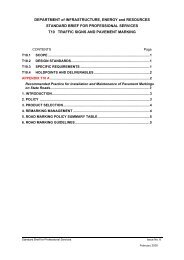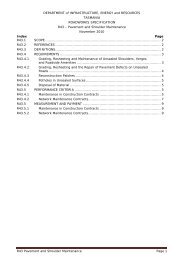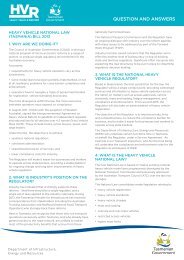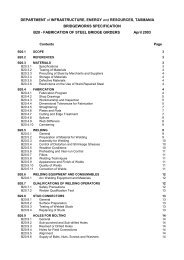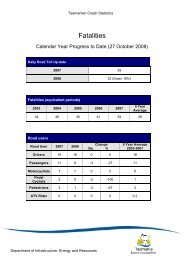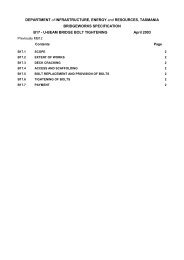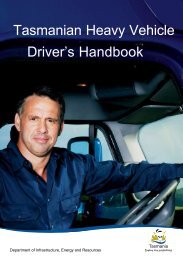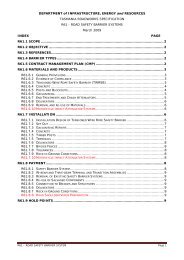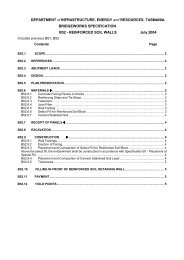Public Environment Report Tarkine Forest Drive ... - Transport
Public Environment Report Tarkine Forest Drive ... - Transport
Public Environment Report Tarkine Forest Drive ... - Transport
- No tags were found...
Create successful ePaper yourself
Turn your PDF publications into a flip-book with our unique Google optimized e-Paper software.
Figure 4.8 - Distribution of pretty leek orchid (Source: Natural Values Atlas March 2012) ...... 59Figure 4.9 - Distribution of short spike midge- orchid (Source: Natural Values Atlas March 2012)................................................................................................................... 61Figure 4.10 - Distribution of western leek orchid (Source: Natural Values Atlas March 2012) .. 63Figure 4.11 - Windswept spider orchid (Source: NBES 2011) .......................................... 65Figure 4.12 - Distribution of windswept spider orchid (Source: Natural Values Atlas March 2012)................................................................................................................... 66Figure 4.13 - Eastern barred bandicoot records in northwest Tasmania and potential habitat inthe study area (Source: NBES 2011) ........................................................................ 75Figure 4.14 - Observation records (including live sightings and roadkill) of Tasmanian devils andspotted-tailed quolls from the study area (Source: NBES 2011) ...................................... 79Figure 4.15 - Tasmanian devil distribution and approximate core habitat (Source DPIPWE 2010)................................................................................................................... 82Figure 4.16 - Distribution of Devil Facial Tumour Disease (Source: Save the Tasmanian Devilwebsite (www.tassiedevil.com.au) (2 August 2012)) ................................................... 84Figure 4.17 – Azure Kingfisher records and known creek habitat ..................................... 94Figure 4.18 – Orange bellied parrot and Wedge-tailed eagle records................................ 95Figure 4.19 – Swift parrot, Masked owl and White-bellied sea-eagle records ...................... 96Figure 4.20 - Wedge-tailed eagle potential nesting habitat within 1 km of the study area(Source: NBES 2011) ......................................................................................... 100Figure 4.21 - Green and gold frog records from northwest Tasmania (Source: NBES 2011) .... 104Figure 4.22 - Potential green and gold frog habitat (Source: NBES 2011).......................... 105Figure 4.23 - Potential Australian grayling habitat (Source: NBES 2011) ........................... 107Figure 4.24 - Waterfall which presents a natural barrier to the Australian grayling (note TemmaRoad Bridge in background) (Source: pitt&sherry) ..................................................... 108Figure 4.25 - Giant freshwater crayfish records from the study area (Source: NBES 2011) ..... 110Figure 4.26 - Marrawah skipper records and potential habitat from the study area (Source:NBES 2011) ..................................................................................................... 112Figure 6.1 - Structure of proposed safeguards and mitigation measures........................... 140Figure 6.2 - Locations of roadkills ......................................................................... 157Figure 6.3 - Roadkill and headlight hotspots ............................................................ 158Figure 6.4 - Tasmania devil and spotted-tailed quoll sightings and roadkills ..................... 159Figure 6.5 - Mitigation trial sites .......................................................................... 162Figure 6.6 - wildlife advisory sign ......................................................................... 163Figure 6.7 - Rumble strip design ........................................................................... 164Figure 6.8 - Distribution of nightly roadkill counts before and after mitigation was employed.Sites Two, Three and Five are treatment sites, while Sites One, Four and Six are the pairedcontrol sites ................................................................................................... 165Figure 6.9 - Operating Speed of the route ............................................................... 168Figure 6.10 - Average Daily Traffic Summary ........................................................... 171Figure 6.11 - Typical cross section ........................................................................ 174Figure 6.12 - adaptive management framework ........................................................ 178Appendix AAppendix BAppendix CAppendix DAppendix EAppendix FAppendix GAppendix HAppendix IAppendix JAppendix KAppendix LAppendix MAppendix NAppendix OMap series of the proposed <strong>Tarkine</strong> <strong>Forest</strong> <strong>Drive</strong>Northbarker Ecosystem <strong>Report</strong>Relevant environmental protection guidelines for matters of NESBenefit cost analysisFinal guidelines<strong>Tarkine</strong> <strong>Drive</strong> – vertebrate carnivore assessment forumRoadkill survey area 2009/2010 mapRoadkill countsSymbolix technical analysis detailsSpeed limit zonesTraffic counters 2009/2010 mapBroad classification of vegetation types mapTasmanian Devil scat locations mapMitigation strategy mapMitigation strategy inset mapRef: HB09080H001 PER <strong>Tarkine</strong> <strong>Drive</strong> 33P Rev 00/DL/CL/jw



